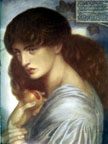In his 1874 picture Proserpine, Dante Gabriel Rossetti illustrates the namesake of the work in the typical style of the PRB. Proserpine is an exquisitely beautiful woman, with her delicately painted facial features; sensitive, slender hands, and flawlessly pale skin set off by her dark thick hair. She holds in one of her hands the fruit that condemned her to live six months in the Underworld. The red of both the pomegranate and her lips appear warm and sensuous compared to the cool palate of the rest of the painting. The girl wears a blue silken gown. Rossetti attentively portrays the creases and folds of the clothing with much detail and realism. An ivy branch curls in the background, while in the foreground, a gold or brass incense burner emits incense smoke. A light — a glimpse of the world of the living — shines into the room, illuminating the morose girl and the far wall. Prosperine's saddened eyes, which are the same cold blue color as most of the painting, indirectly stare at the other realm. Overall, dark hues characterize the color scheme of the piece.

Proserpine is a young woman in Greek and Roman mythology who is kidnapped by Pluto, the god of the Underworld. Pluto brings the girl down into his kingdom with the intentions of making her his wife. Proserpine, unhappy and miserably wishing to be back in the world of the living, only eats a few seeds of pomegranate. However, since she consumes some of the food of the Underworld, she becomes bound to that realm and must become Pluto's wife. Pluto and Ceres, Proserpine's mother, make a deal in which Proserpine stays in the Underworld for half of a year and resides with the living for the other six months.
Questions
1. Jane Morris, wife of William Morris, served as the model for Proserpine. Rossetti tried to seduce Jane, and she took part in an affair with him because she was very unhappy with her marriage. Along with his pictorial work Proserpine, Rossetti wrote an accompanying poem expressing, in part, his love for Jane. He writes, "And still some heart onto some soul doth pine." How does the story of Proserpine relate so well to the developing situation between Rossetti and Jane? What does the light from the living world symbolize in respect to Jane's marriage?
2. Typical of PRB pieces, Proserpine contains symbols which lend deeper meaning to the work. Rossetti did not put objects into his pictures without a purpose in doing so. What, then, might the ivy branch represent? The incense burner? Can the pomegranate, also known as a "passion fruit," symbolize anything in Jane's situation?
3. Rossetti chose to express his emotions through both picture and words. The art piece expresses both Rossetti and Jane's deep melancholy through the downcast eyes of Proserpine and the subdued colors used. The poem also develops this sadness. What words and techniques make this poem particular effective? Do you think that the use of the first-person point of view is effective and the best view point to employ? Why or why not?

4. In your opinion, can the painting and the poem stand alone on their own merits? Or does each piece need the other to complete it? Is one mode of expression more effective than the other?
5. Consider Beatrice, a Portrait of Jane Morris. Rossetti used Jane Morris as his model for the women in both this work and Proserpine. By looking at both pieces, it is clear the same woman modelled for both. However, does Rossetti express the same gloom in Beatrice as he did in Proserpine? Is one painting more effective or powerful than the other?
Related Materials
Last modified 4 October 2004